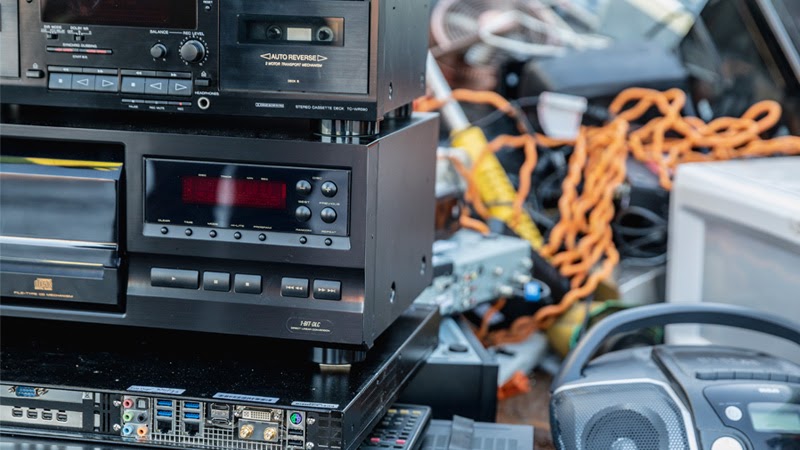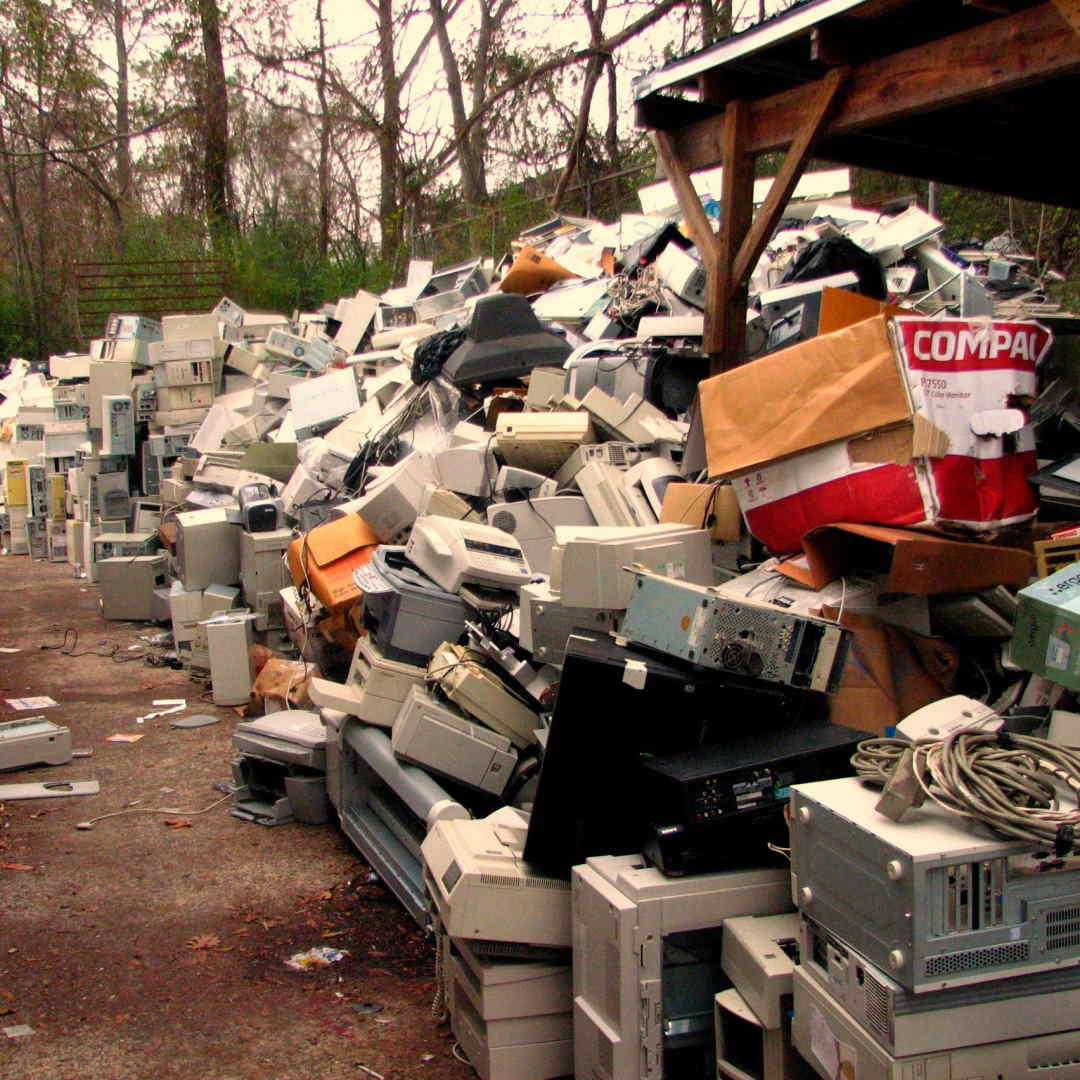Holidays often mean an influx of new gadgets and technology into our homes. But what does that mean for the old, broken and unwanted items?
Unfortunately, many of those items will end up either in a junk drawer, or the landfill, which is problematic for a few reasons that we will explore below. This action – or inaction – often stems from a lack of knowledge and awareness about “e-waste”. Like many environmental issues, the concerns around e-waste – what it is, why it is a problem, and what to do about it – can get complicated. Let’s dive into these three areas today to help you make sense of it, and take action to reduce its impact in our communities.
WHAT IS E-WASTE AND WHY DOES IT EXIST?
E-waste is a broad category. Simply put, it is any item that can be plugged in or has a battery that has reached the end of its life by losing its value to the user or because it no longer functions to its original specification. Even more simply put, it’s broken or unwanted tech that we want to dispose of. Considering the speed at which tech companies release new products and the societal pressure to own the newest and best, it is the fastest growing waste stream (EWaste Monitor).
Much of the current e-waste exists because producers have made it impossible to repair these items. Many consumer advocacy groups have written about the concept of “planned obsolescence”. While we cannot be 100% sure this is taking place, the evidence continues to show that the lifespan of electronic goods is becoming shorter. (Consumers International). Adding to our inability to repair broken tech, traditionally, there is a very low percentage of e-waste that is recycled – about 17.4% globally (CBC News).

WHY IS IT A PROBLEM?
Similar to paper and plastic, much of our e-waste is recyclable. Reusing components can reduce manufacturing costs and prevent the need to obtain new resources. We also save landfill space when those items are diverted to recyclers, or for reuse. Canada alone generated 638,300 tonnes of electronic waste in 2017 (CBC News), and even if only a portion of this is diverted, it can clearly have a substantial impact.
Like with any system that impacts our environment, there are some mild to extreme negative consequences when we fail to take action.
E-waste is a health hazard, as many of those electronics contain toxic substances such as mercury, lead, cadmium, and more (City of Edmonton). When dumped into a landfill, these toxins can leach into the ground and contaminate our water supply, among other things. Unfortunately, even when we send our broken or unwanted electronics in for recycling, these toxic chemicals can have a devastating impact on other communities.
ENVIRONMENTAL JUSTICE
In most industrialized countries (including Canada), it is illegal to send e-waste to “developing nations”, but some private recycling companies continue this practice (CBC News). And in the United States, there are no such regulations for export, which is why we continue to see electronic dumps across West Africa, India, and China. While many of these places have vibrant communities (Welcome to Sodom), they are also dealing with high rates of cancer and no occupational regulations to protect them or their families (PBS.com). And any items that are not profitable to recycle are still dumped, with no environmental recourse. On the production side of the equation, there are equal human rights abuses, including outright slavery or “forced labour” (Kevin Bales).
WE HAVE THE SOLUTIONS!
The good news is that we have many solutions available now. We just need to take them. Edmontonians have access to a network of Eco Stations that accept personal e-waste for recycling and disposal. There is a limit to what they will accept and aren’t accessible to all folks equally (individuals without personal vehicles, for example).
According to the waste hierarchy, e-waste collection and recycling should be our last resort (CBC Radio). We need to ensure that we are first and foremost reducing our waste, and then reusing individual or overall components. There are two systemic solutions that have been adopted in some countries to address the idea that we cannot rely on recycling alone.
Extended Producer Responsibility (EPR) is defined as a “policy approach in which a producer’s responsibility for a product is extended to the post-consumer stage of the product’s life cycle” (EPR Canada). EPR regulations are intended to push the producers of goods to consider – and potentially change – product design to make items easier to recycle or reuse once they have reached their end-of-life. Bottle depots are a simple and familiar example of an EPR. Ideally, this policy approach helps eliminate the accumulation of e-waste in landfills by redirecting those products back to the producer, and ultimately preventing e-waste once these producers take steps to ensure their products are better designed and longer lasting. Provinces in Canada have been working toward full implementation of provincial EPR legislation since 2009.
Right to Repair is a concept that is gaining traction in Europe, and made some headway in Ontario recently (Policy Alternatives). Environmental groups and politicians are focused on creating regulations and legislation to allow consumers to repair their own devices. This includes eliminating the use of proprietary parts, and demanding that companies redesign products so they can easily be taken apart. Consumers are often – if not always – forced to use a manufacturer-authorized repair service at greater expense, or ultimately replace with a new product because repair is unavailable or impossible. There are a number of benefits to these regulations in terms of employing them to prevent e-waste. By removing barriers and access to repair, more consumers will have control over the longevity of their electronic devices.
TAKE ACTION
Now that you have learned a bit about e-waste and its significance in our waste stream, here are some individual actions you can take right now.
Low effort
- Evaluate your need to buy new gadgets, appliances, or technology. Consider instead: Can I borrow the item from a friend, family or local “Tool Library”? Can I buy this item secondhand?
- If you are replacing an item that is still in working condition, consider donating it to a local organization who can refurbish it and get it into the hands of someone who couldn’t otherwise afford it. Look into the Electronics Recycling Association to start.
Mid effort
- Before you replace an item, try repairing it instead. There are many local cell phone repair shops who will replace a screen or battery for a reasonable rate. Or if you prefer the DIY route, order parts or a repair kit online. Even without “Right to Repair” legislation in place, there are options available to consumers.
- Write a letter to your local newspaper expressing your concern for e-waste, or make a complaint to the Office of Consumer Affairs (Canada) requesting Right to Repair or Extended Producer Responsibility legislation.
- Create your own “Tool Library” or “Skills Library” by compiling a list of your big ticket appliances, technology, and tools that you are willing to lend out, or specialized skills you have. Then send the list out to friends and family.
Most effort
- Work with your company, local community league, or homeowner’s association and organize an e-waste drive in your community or workplace. Offer a reward for the family/individual who brings in the oldest tech or the most items!
- Start a dialogue with your neighbours — are you going to the Eco Station? Mention it well in advance and offer some space in your vehicle to help others get rid of their e-waste.
As consumers, we can take small steps in our homes and communities to combat these human rights abuses and help protect our environment at the same time. But as leading activists show (Guardian) the real change must come from governments to enact and enforce stronger laws and regulations, and corporations to design better and longer lasting products.
FURTHER READING
Where does America’s e-waste end up? GPS tracker tells all (PBS)
Record 53.6 million tonnes of e-waste dumped globally last year, says UN report (CBC)
Not Designed for Recycling (Electronics Take Back Coalition)
Did the Right to Repair get left behind? (What’s Your Tech)
Right to Repair (Wikipedia)
Extended producer responsibility for e-waste management: policy drivers and challenges (Science Direct)


